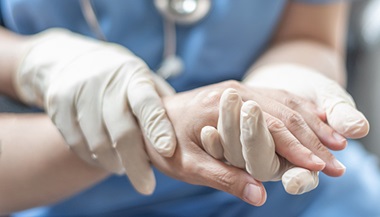Macrodactyly (Large Fingers or Large Toes)
What You Need to Know
- Static macrodactyly causes long or wide digits that are noticeable at birth.
- Progressive macrodactyly occurs during early childhood when certain digits start to grow larger than others.
- Treatment for macrodactyly often involves surgery, as well as physical and occupational therapies.
What is macrodactyly?
Macrodactyly causes certain fingers or toes to grow larger than usual. The larger digits may be long, wide, stiff or curved. This congenital (present at birth) limb difference typically affects more than one digit on the same hand or foot.
Large fingers (macrodactyly fingers) are a congenital hand difference. They are more common than large toes (macrodactyly toes).
Macrodactyly can affect a person’s appearance, as well as their ability to use their hands or feet. Some people also have webbed fingers or webbed toes (syndactyly).
Types of Macrodactyly
There are two main types of macrodactyly:
Static Macrodactyly
Static macrodactyly is evident at birth. A newborn has fingers or toes that are longer or larger than other digits. The larger digits grow at the same rate as the unaffected ones.
Progressive Macrodactyly
Progressive macrodactyly typically appears before age 2. A newborn’s digits are the expected sizes at birth. Then, one or more digits starts to grow at a faster rate than the others.
What causes macrodactyly?
A gene change (mutation) often causes macrodactyly. This gene change seems to occur for no known reason. Macrodactyly is not inherited. It does not typically run in families.
Children with one of these conditions are more likely to have macrodactyly:
- Multiple enchondroma, including Maffucci syndrome, including neurofibromatosis
- Vascular malformations
How is macrodactyly diagnosed?
A doctor may order an X-ray or MRI to view bones and tissues in the enlarged digits. Your child may also get a genetic test (a type of blood test) to check for a gene mutation or conditions that cause macrodactyly.
Macrodactyly Treatments
Some children with minor finger or toe enlargement may not need treatment. A doctor will monitor the digits for growth. When appropriate, they may recommend one of these treatments:
Macrodactyly Surgery
Severely long fingers or toes may require surgery to shorten bones, nerves, blood vessels and soft tissues. In most instances, a child will need multiple surgeries beginning as early as infancy or toddlerhood. They may continue to need surgeries throughout their teen years and into adulthood.
A child may get one or more of these surgeries depending on the rate the normal digits grow compared to the large ones:
- Epiphysiodesis: A surgeon closes growth plates in the affected digits to stop them from getting longer. The digits may still grow wider. This treatment often takes place after the digits reach an adult length.
- Ray resection (ray amputation): A surgeon removes the enlarged digits. A doctor may recommend amputation for severe progressive macrodactyly that affects function or appearance.
- Shortening procedures: A surgeon removes sections of bone from the affected digits. This procedure often takes place after the digits have stopped growing or reach an adult length.
- Soft tissue debulking: A surgeon removes thickened skin and fat layers in the affected digits. This staged procedure for mild macrodactyly takes place over several months. Debulking may also be part of a series of treatments for progressive macrodactyly.
After surgery, a child wears a splint or cast while the digits heal.
Physical and Occupational Therapies for Macrodactyly
People of all ages with macrodactyly may benefit from physical therapy, occupational therapy or hand therapy. These therapies improve mobility and function. People with mild macrodactyly may only need therapy and not surgery.
What is the outlook for people living with macrodactyly?
The outlook for someone with macrodactyly varies depending on the condition type and severity. Surgery often takes place during childhood, but in some cases, more than one surgery is needed as a child grows. Even with surgery, the affected digits may not look, move or function like the other digits. However, most people can use their hands and feet effectively.






